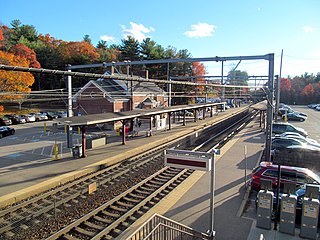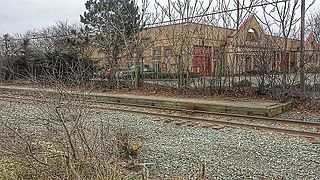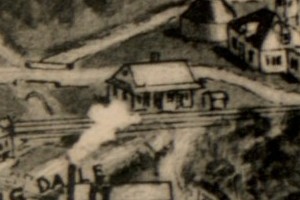
The MBTA Commuter Rail system serves as the commuter rail arm of the Massachusetts Bay Transportation Authority's (MBTA's) transportation coverage of Greater Boston in the United States. Trains run over 394 mi (634 km) of track to 135 stations. It is operated under contract by Keolis, which took over operations on July 1, 2014, from the Massachusetts Bay Commuter Railroad Company (MBCR).

Route 128 station is a passenger rail station located at the crossing of the Northeast Corridor and Interstate 95/US Route 1/Route 128 at the eastern tip of Dedham and Westwood, Massachusetts, United States. The station is shared by Amtrak and the Massachusetts Bay Transportation Authority (MBTA). It is served by most MBTA Commuter Rail Providence/Stoughton Line trains, as well as by all Amtrak Northeast Regional and Acela intercity trains. The station building, platforms, and parking garage are all fully accessible. It is the 23rd busiest Amtrak station in the country and the fifth busiest in New England.

Forest Hills station is an intermodal transfer station in Boston, Massachusetts. It serves the MBTA rapid transit Orange Line and three MBTA Commuter Rail lines and is a major terminus for MBTA bus routes. It is located in Forest Hills, in the southern part of the Jamaica Plain neighborhood. Most Providence/Stoughton Line and Franklin/Foxboro Line trains, and all Amtrak Northeast Corridor trains, pass through the station without stopping. Forest Hills station is fully accessible on all modes.

The Boston and Providence Railroad was a railroad company in the states of Massachusetts and Rhode Island which connected its namesake cities. It opened in two sections in 1834 and 1835 - one of the first rail lines in the United States - with a more direct route into Providence built in 1847. Branches were built to Dedham in 1834, Stoughton in 1845, and North Attleboro in 1871. It was acquired by the Old Colony Railroad in 1888, which in turn was leased by the New Haven Railroad in 1893. The line became the New Haven's primary mainline to Boston; it was realigned in Boston in 1899 during the construction of South Station, and in Pawtucket and Central Falls in 1916 for grade crossing elimination.

Roxbury Crossing station is a rapid transit station in Boston, Massachusetts. It serves the MBTA Orange Line, and is located on Tremont Street in the Mission Hill neighborhood. The current station opened in 1987 as part of the renovation and relocation of the southern Orange Line. Like all stations on the Orange Line, Roxbury Crossing is accessible.

The Providence/Stoughton Line is an MBTA Commuter Rail service in Massachusetts and Rhode Island, primarily serving the southwestern suburbs of Boston. Most service runs entirely on the Northeast Corridor between South Station in Boston and Providence station or Wickford Junction station in Rhode Island, while the Stoughton Branch splits at Canton Junction and terminates at Stoughton. It is the longest MBTA Commuter Rail line, and the only one that operates outside Massachusetts. The line is the busiest on the MBTA Commuter Rail system, with 17,648 daily boardings in an October 2022 count.

Canton Junction station is an MBTA Commuter Rail station in Canton, Massachusetts. It serves the Providence/Stoughton Line, and is planned for future service on the South Coast Rail line. It is located slightly north of the Canton Viaduct and west of downtown Canton.

Readville station is a Massachusetts Bay Transportation Authority (MBTA) commuter rail station located in the Readville section of the Hyde Park neighborhood of Boston, Massachusetts. It is served by the MBTA Commuter Rail Fairmount, Franklin/Foxboro, and Providence/Stoughton Lines. Readville is the outer terminus for most Fairmount service, though some trips continue as Franklin/Foxboro Line trains. The station is located at a multi-level junction, with the Attleboro Line tracks at ground level and the Dorchester Branch above. Franklin/Foxboro Line trains that run on the Northeast Corridor use a connecting track with a separate platform. An MBTA maintenance and storage yard and a CSX Transportation freight yard are located near the station.

Springdale station is a commuter rail station on the New Canaan Branch of the Metro-North Railroad New Haven Line in Springdale, Stamford, Connecticut. The station opened in 1868, and was rebuilt in 1972.

Attleboro station is a commuter rail station on the MBTA's Providence/Stoughton Line located in Attleboro, Massachusetts. By a 2018 count, Attleboro had 1,547 daily riders, making it the fourth busiest station on the system outside Boston.

Mansfield station is an MBTA Commuter Rail station in Mansfield, Massachusetts. Located in downtown Mansfield, it serves the Providence/Stoughton Line. With 1,966 weekday boardings in a 2018 count, Mansfield is the third-busiest station on the system outside Boston.

Sharon station is an MBTA Commuter Rail station in Sharon, Massachusetts. It serves the Providence/Stoughton Line. The station has two separate entrances for inbound trains to Boston and for outbound trains to Providence and beyond. New platforms were constructed in 2014 to make the station accessible.

Canton Center is an MBTA Commuter Rail station in Canton, Massachusetts. It serves the Providence/Stoughton Line, including most Stoughton Branch service except for evening inbound trains. The station has 1 side platform on the south side of the track west of Washington Street; the platform has a mini-high section for accessibility.

Stoughton station is an MBTA Commuter Rail station in downtown Stoughton, Massachusetts. It is the current terminus of the Stoughton Branch of the Providence/Stoughton Line. The station has a parking lot to serve local riders and those driving from further south, as Stoughton is close to the Massachusetts Route 24 expressway. Stoughton currently has one platform serving one track; the platform has a mini-high section for accessibility.

Back Bay station is an intermodal passenger station in Boston, Massachusetts. It is located just south of Copley Square in Boston's Back Bay and South End neighborhoods. It serves MBTA Commuter Rail and MBTA subway routes, and also serves as a secondary Amtrak intercity rail station for Boston. The present building, designed by Kallmann McKinnell & Wood, opened in 1987. It replaced the New Haven Railroad's older Back Bay station – which opened in 1928 as a replacement for an 1899-built station – as well as the New York Central's Huntington Avenue and Trinity Place stations which had been demolished in 1964.
The Dighton and Somerset Railroad, currently referred to as the Dean Street Industrial Track, is a railroad that ran between Fall River and Braintree, Massachusetts. It opened in 1866; from the 1890s to the 1930s and again in the late 1950s, it was the primary rail route from Boston to the South Coast. Passenger service ended in stages with the final regular service in 1958, though freight service on two short segments continues into the 21st century. MBTA Commuter Rail service is proposed to be extended onto the northern part of the line around 2030 as part of the South Coast Rail project.

Taunton station was a passenger rail station located south of Oak Street in downtown Taunton, Massachusetts. As Taunton Central station, it served local and Boston-focused routes from 1836 to 1964. A later station at the same site served Amtrak's Cape Codder from 1986 to 1996, and Cape Cod and Hyannis Railroad commuter trains in 1988.

The Dedham Branch was a spur line of the Boston and Providence Railroad, opened in 1835, which ran from the junction with the main line at Readville through to central Dedham; it was the first railroad branch line in Massachusetts. In 1966, it became part of the MBTA Commuter Rail system, but was abandoned the next year.

The history of rail in Dedham, Massachusetts begins with the introduction of the first rail line in 1836 and runs to the present day. Multiple railroads have serviced Dedham since then, and current service is provided by the MBTA. The station in Dedham Square built in 1881 out of Dedham Granite was demolished in 1951 and the stones were used to put an addition on the Town's library. There are two active stations today, and multiple others in close proximity.
The 88 stations case was a 1935–40 controversy and court case involving the Old Colony Division of the New York, New Haven and Hartford Railroad. The New Haven entered bankruptcy in 1935; the next year, it ended the 1893 lease of the unprofitable Old Colony Division, but continued operating those lines by court order. The Old Colony and New Haven closed 88 stations in Massachusetts on July 18, 1938, ending passenger service altogether on some lines. In May 1939, the Old Colony filed to abandon all freight and passenger service on its lines. In November 1939, the Supreme Court of the United States ruled in Palmer v. Massachusetts that a district court did not have authority to order the discontinuance of intrastate passenger service. Thirty-two of the stations were reopened in 1940, with 40 percent of service cut in lieu of total abandonment.


















